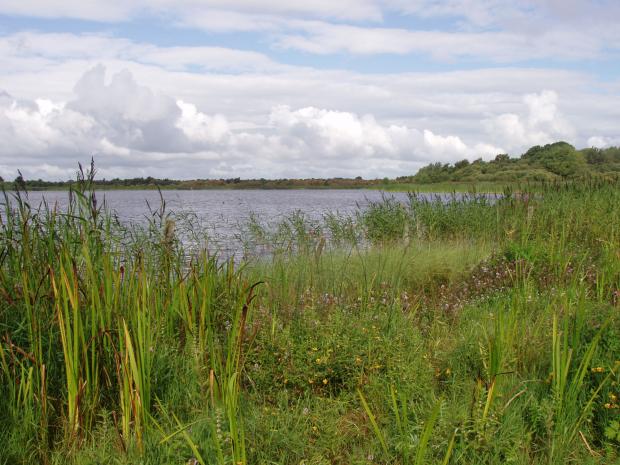
Lough Gullion is of special scientific interest for its wetland flora and fauna. Good quality fen, swamp and freshwater communities occur, and additional diversity is provided by wet grasslands, cut-over bog, scrub and wet woodland. A wide range of wetland plants are present, some of which are scarce. In addition, the area is locally important for invertebrates and birds.
The lough itself is eutrophic and contains a range of aquatic plants. Macrophytes such as fennel pondweed, Canadian waterweed and spiked water-milfoil form mixed submerged beds, while yellow water-lily forms floating rafts on the surface.
The lough margin is fringed by a band of emergent swamp vegetation that has a high diversity of vegetation communities comprising stands of water horsetail, bottle sedge and common reed. Most notably, the swamp community to the east of Lough Gullion supports the scarce lesser bulrush, together with the notable flowering-rush, gypsywort and cowbane. This swamp is occasionally interspersed with pockets of wet woodland which is dominated by grey willow and alder.
The tall herb fen forms a natural transition from the open water and swamp communities to areas of semi-improved wet grassland, cut-over bog and wet woodland. The tall herb fen is dominated by sedges such as bottle sedge and common sedge with associated higher plants including water horsetail, purple-loosestrife, marsh cinquefoil, common marsh-bedstraw, greater bird’s-foot-trefoil and water mint. Less frequent herbs include gypsywort, wild angelica and skullcap.
Bryophyte cover is generally high and is dominated by pointed spear-moss. Where the fen community is slightly more acidic in character, particularly where it forms the transition to cut-over bog, bottle sedge and white sedge predominate, with bogbean, marsh cinquefoil, common marsh-bedstraw and occasional common cottongrass.
Semi-natural habitats associated with the swamp and fen provide further structural diversity. Along the western shores of the lough, there is a natural transition from fen into wet grassland and cut-over bog. The wet grassland is dominated by sharp-flowered rush and creeping bent with species such as crested dog’s-tail, sweet vernal-grass, lesser spearwort, meadowsweet, Devil’s-bit scabious, ragged-Robin and carnation sedge. The cut-over bog is dominated by purple moor-grass over a carpet of bog-mosses with sweet vernal-grass, tormentil, wild Angelica, star sedge and most notably common meadow-rue. Royal fern is prominent on the drier banks within the area of cut-over bog.
Pockets of woodland and scrub occur right around the periphery of Lough Gullion. The wet woodland is largely comprised of grey willow and alder with ash, hawthorn and holly occurring in the drier areas. The field layer is comprised of bramble and scattered ferns. The ground flora is highly variable, but generally indicative of transitional wet woodlands with frequent common nettle, common reed and Yorkshire-fog, and scattered wild Angelica, meadowsweet. Most notably, the scarce Cyperus sedge occurs in the wet woodland to the east of the Lough.
In addition to Cyperus sedge, a number of additional scarce plant species have been recorded from the area. These include frogbit in the open water and lesser bulrush in the swamp. Arrowhead is also recorded in the swamp communities. Notable species recorded in the fen include needle spike-rush, cowbane and common meadow-rue. Lough Gullion also supports a rich wetland invertebrate community, a direct consequence of the diversity of the swamp and fen communities and associated wetland habitats.
Related articles
- ASSI Guidance for Public Bodies/Competent Authorities
- Coastal Areas of Special Scientific Interest
- Conservation Management Plans (CMPs)
- European Marine Sites - Marine Special Areas of Conservation and Special Protection Areas
- Introduction to Conservation Management Plans (CMPs) for Northern Ireland’s Special Areas of Conservation
- Marine Conservation Zones
- Marine Protected Areas
- Marine Ramsar sites
- Portrush Coastal Zone
- Special Areas of Conservation
- Special Areas of Conservation for Harbour porpoise
- Special Protection Areas
